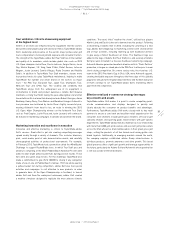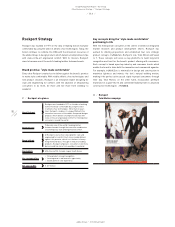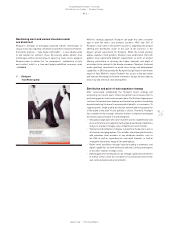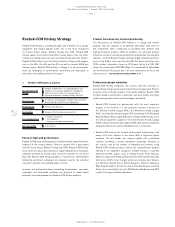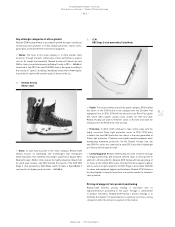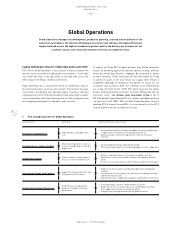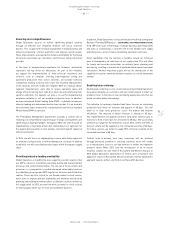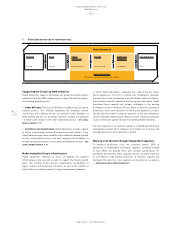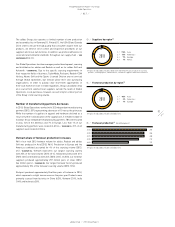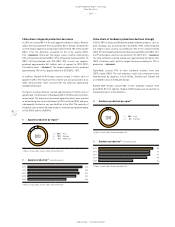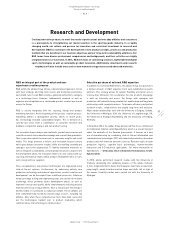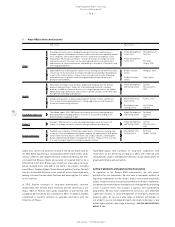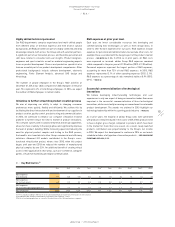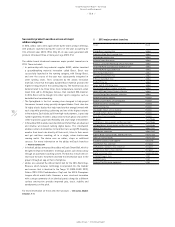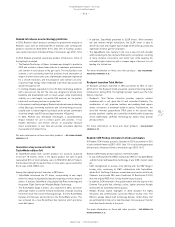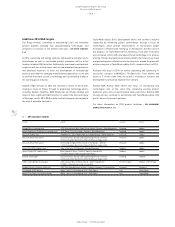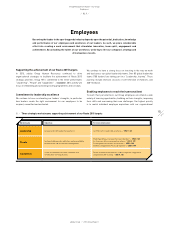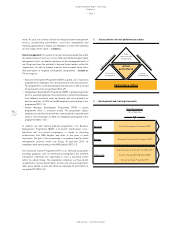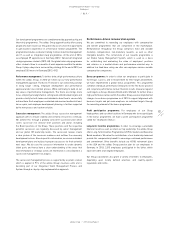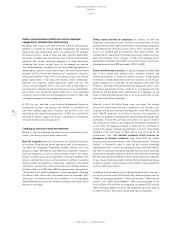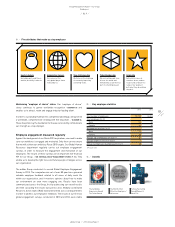Reebok 2013 Annual Report Download - page 103
Download and view the complete annual report
Please find page 103 of the 2013 Reebok annual report below. You can navigate through the pages in the report by either clicking on the pages listed below, or by using the keyword search tool below to find specific information within the annual report.
8
adidas Group
/
2013 Annual Report
Group Management Report – Our Group
99
2013
Research and Development
/
02.8
/
Research and Development
Creating innovative products to meet the needs of professional and everyday athletes and consumers
is a prerequisite to strengthening our market position in the sporting goods industry. In a rapidly
changing world, our culture and passion for innovation and consistent investment in research and
development (R&D) is essential to the development of new product concepts, processes and production
methods that are beneficial to our business objectives and our long-term sustainability ambitions. Our
R&D teams have diverse professional competencies and backgrounds, and their activities are highly
integrated and cross-functional. In 2014, R&D will focus on cushioning solutions, lightweight and digital
sports technologies as well as sustainable product innovation. Additionally, investments and research
emphasis will also include areas such as new manufacturing processes and advanced materials.
R&D an integral part of the product and user
experience creation process
R&D within the adidas Group follows a decentralised approach. In line
with their strategic and long-term visions and distinctive positioning,
each brand runs its own R&D activities, generally with either a category
or a technology focus. However, fundamental research as well as
expertise and competencies in sustainable product creation are shared
across the Group.
R&D is closely integrated with the sourcing, design and product
marketing functions. At the beginning of the product creation process,
marketing defines a development priority, which, in recent years,
has increasingly included sustainability targets. This is derived on a
case-by-case basis from a combination of consumer research and
feedback, competition analysis and own product testing.
Our innovation teams analyse new materials, production processes and
scientific research to increase the exchange and scope of idea generation.
Their scope also extends to areas such as consumer insights and social
media. This helps promote a holistic and innovation-focused culture
which gives deeper consumer insights, while also fuelling creativity and
synergies across the organisation. To identify innovative materials as
well as integrate sustainability, cost and production process aspects into
the development phase, the innovation team is in close contact with our
sourcing and material teams within product development who, in turn,
work closely with our suppliers.
Once conceptualised, new product technologies are engineered using
state-of-the-art systems. Furthermore, by embracing entirely new
production technology and material approaches, product creation and
development can be decoupled from traditional processes. Extensive
virtual prototype testing and engineering loops are carried out on every
technology, which promotes faster development phases as well as
improved concept and quality, while simultaneously reducing physical
material and resource requirements. Once a new product technology is
deemed viable, it is produced as a physical sample. These samples are
then comprehensively tested by a broad range of users, including top
athletes. Only when these comprehensive tests have been successful
are the technologies handed over to product marketing, which
commercialises the technology to a final product.
Selective purchase of external R&D expertise
In addition to its internal R&D efforts, the adidas Group also purchases
a limited amount of R&D expertise from well-established research
partners. This strategy allows for greater flexibility and faster access
to know-how. Moreover, this accelerates the rate at which knowledge
is built up internally and across the Group, with synergies and
productive skill networks being created that enable deep and long-term
relationships with research partners. To increase efficiency and protect
research results, collaborations are usually long-term and exclusive.
Major adidas relationships exist with the University of Calgary, Canada,
the University of Michigan, USA, the University of Loughborough, UK,
the University of Erlangen-Nuremberg and the University of Freiburg,
Germany.
In November 2013, the adidas Group announced that it has commenced
a collaborative initiative called Speedfactory, which is a research project
under the umbrella of the German government. It focuses on a new
era of manufacturing by combining state-of-the-art information and
communication technologies (ICT) with industrial production, innovative
products and skill-intensive electronic services. Research topics include
production logistics, cognitive basic technologies, human-machine
interaction and 3-D industrial applications. For more information on
Speedfactory :
//
WWW.ADIDAS-GROUP.COM/EN/GROUP/STORIES/ADIDAS-FUTURE-
MANUFACTURING.
In 2013, adidas performed research studies with the University of
Freiburg, developing and validating features of the adidas miCoach
X_Cell, a digital biometric device that measures heart rate, acceleration,
jump height, speed-to-brake reaction times and shifts left or right of
the wearer. Usability studies were carried out with the University of
Michigan.


